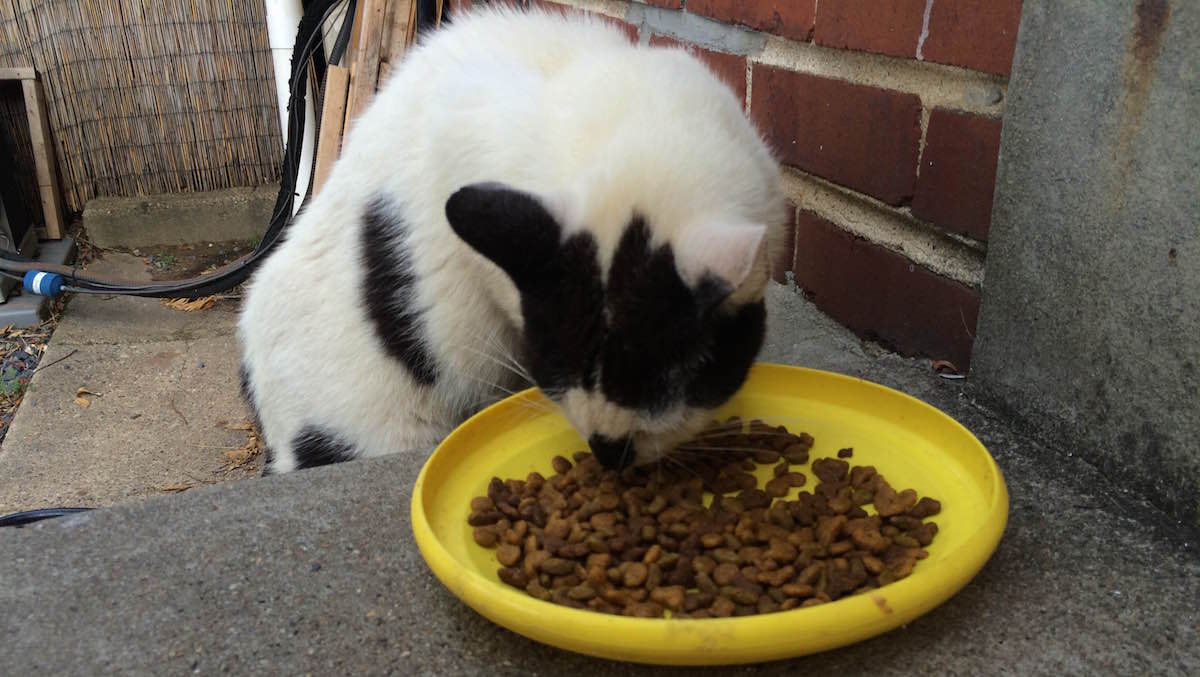Curbing an overabundance of feral cats in East Falls

(Alaina Mabaso/for NewsWorks)
East Falls resident Katie Battista never set out to harbor cats.
“Cats definitely are not my favorite animal,” the self-described dog lover said. So it’s a surprise that she and her husband are now caretakers to a Cresson Street colony of about six feral cats living in their yard.
Not all of her neighbors appreciate it, she says, and she sympathizes. “I’m personally self-conscious about this, because I never pictured myself in this situation of feeding these feral cats,” she said.
‘The socially responsible thing to do’
Battista, a grad student in health policy at the University of the Sciences, participates in a trap-neuter-return program through the Animal Care and Control Team of Philadelphia (ACCT Philly). The TNR program spays, neuters and vaccinates cats, and returns them to the neighborhood. The aim is to control the population, and save the lives of the animals.
“It’s not that we want to be doing this. It’s the socially responsible thing to do. We can’t just keep letting them procreate and make more and more kittens,” Battista said.
The proliferation of cats on Cresson Street got started about 18 months ago, she said, when a neighbor began feeding feral cats in his yard. No steps were taken to control the cat population, and the litters multiplied. With the help of ACCT Philly, she and her husband fostered one mama cat and her seven kittens through the winter — the first cats she took in.
Now, including that first family, the couple has trapped 27 cats and kittens. With a combination of personal connections and some help from local animal-welfare agencies, all but six have been adopted into local homes.
Battista ended up with her own house cat after it returned to her with a broken leg. The cat, which was the first mother cat she fostered, was released after spaying and vaccination treatments through ACCT Philly were completed in the spring. That fall, the cat showed up with the broken leg.
After an exam and X-ray, Battista remembered, a vet confirmed that the cat’s injury was intentionally inflicted: “She was 100 percent sure it was a violent act,” Battista said, such as a kick or a hit from a baseball bat. After the cat was patched up, Battista took it home.
Public’s reaction to neighborhood cats
The Philadelphia chapter of the national Best Friends Animal Society estimates that the city has as many as 400,000 cats roaming outside, said Tara Schernecke, field services director of ACCT Philly. And people’s reactions to them are mixed.
“Sometimes people look at cats in the same way they do wildlife, as a nuisance, [with] destruction of property and things like that,” she said. “And then you have the opposite people who are upset that the cats are outside.”
Many of these feral cats, though they may be friendly, were born into life outside a home and cannot make the adjustment to becoming family pets. They are often left behind when people move, or are from the litters of unaltered (neither spayed or neutered) cats that are allowed to roam outside by their owners.
“We can come out to block meetings or community meetings to speak to people about the situation and what they can do,” said Germantown resident Aine Doley, Best Friends’ Community Cats Project coordinator.
A big part of ACCT Philly’s work is to help people keep cats off their property in humane ways, Schernecke said, while educating them about how well cats adapt to life outside once they have been trapped, vaccinated, altered and released. Some live healthy lives on their own.
A little advice on what to do
Battista and her husband buy a bag of cat food during their weekly shopping, and feed their colony of black-and-white cats morning and night, using a couple of old Frisbees as dishes. Battista, who works at a pharmacy, converted about five large Styrofoam drug-shipping containers into what she calls “the rowhomes” for the community cats.
She urged neighbors to get involved with TNR to help cut back the population.
“If you’re in a neighborhood with a feral cat population, stop complaining about it, or even judging people that are trying to help the situation,” she said. Do something about it, she added.
“At the very least, don’t hit the cats with a bat. At the very least, don’t make the problem any worse.”
ACCT offers online information and resources for people who want to address cat colonies in their neighborhoods.
WHYY is your source for fact-based, in-depth journalism and information. As a nonprofit organization, we rely on financial support from readers like you. Please give today.




